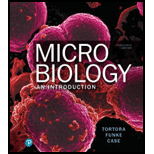
Microbiology: An Introduction Plus Mastering Microbiology with Pearson eText -- Access Card Package (13th Edition) (What's New in Microbiology)
13th Edition
ISBN: 9780134688640
Author: Gerard J. Tortora, Berdell R. Funke, Christine L. Case, Derek Weber, Warner Bair
Publisher: PEARSON
expand_more
expand_more
format_list_bulleted
Question
Chapter 25, Problem 5R
Summary Introduction
To review:
Mycotoxin with an example.
Introduction:
Microorganisms that have the ability to cause infectious diseases are called as pathogens. Such microorganisms include bacteria,
Expert Solution & Answer
Want to see the full answer?
Check out a sample textbook solution
Students have asked these similar questions
pls help
What habitat/environment is the colobus monkey found in
4
Chapter 25 Solutions
Microbiology: An Introduction Plus Mastering Microbiology with Pearson eText -- Access Card Package (13th Edition) (What's New in Microbiology)
Ch. 25 - Complete the following table:Ch. 25 - Complete the following table:Ch. 25 - DRAW IT Identify the site colonized by the...Ch. 25 - Prob. 4RCh. 25 - Prob. 5RCh. 25 - Explain how the following diseases differ and how...Ch. 25 - Prob. 7RCh. 25 - Complete the following table:Ch. 25 - Look at life cycle diagrams for human tapeworm and...Ch. 25 - Prob. 10R
Ch. 25 - Prob. 1MCQCh. 25 - Prob. 2MCQCh. 25 - Prob. 3MCQCh. 25 - Gastric ulcers are caused by a. stomach acid. b....Ch. 25 - Microscopic examination of a patients fecal...Ch. 25 - Prob. 6MCQCh. 25 - Identification is based on the observation of...Ch. 25 - Prob. 8MCQCh. 25 - Prob. 9MCQCh. 25 - This microbe is frequently transmitted to humans...Ch. 25 - Why is a human infection of trichinella considered...Ch. 25 - Complete the following table:Ch. 25 - Match the foods in column A with the microorganism...Ch. 25 - Which diseases of the gastrointestinal tract can...Ch. 25 - Prob. 1CAECh. 25 - Prob. 2CAECh. 25 - Prob. 3CAECh. 25 - Three to 5 days after eating Thanksgiving dinner...
Knowledge Booster
Similar questions
- Does it show the level of proteins? What about the amount? Levels of protein activation? How can you tell? Does the thickness tell you anything? What about the number of the lines? And the other questionsarrow_forwardKD 200- 116- 66- Vec ATF6 (670) ATF6 (402) ATF6 (373) ATF6 (366) I I 45- 1 2 3 4 5 ATFG (360) (e/c) 9V ATFG (402) g ant- ATF anti-KDEL DAPI barrow_forwardWestern blot results: what information can you get? Presence of proteins of your interest Levels of protein expression Levels of protein activation (must use activation state-specific antibody) Decreased function of the ATM kinase in aging mice. A C57BL/6 female 6 month Con IR 20 month C57BL/6 male 6 month 28 month Con IR Con IR Con IR p-ATM (S1981) ATM P-p53 (ser18) Actinarrow_forward
- Does it show the level of proteins? What about the amount? Levels of protein activation? How can you tell? Does the thickness tell you anything? What about the number of the lines?arrow_forwardWB: Protein of interest visualized by fluorescent Protein A Protein Barrow_forwardQuestion #4: Assume you are able to use CRISPR to create an allele that will convert a cross-pollinated, sexually reproducing crop plant into an obligate apomict. Your edited obligate apomict plants retains all the CRISPR "machinery" necessary to convert the "sexually reproducing" allele to the "obligate apomict" allele. You plant 100 hectares of your edited obligate apomicts in order to increase seed for sale the following year. Neighboring farms and seed producers are growing many different un-edited sexually reproducing varieties of the crop. If your neighbors plant seed harvested from their crops that was pollinated by your crop, should they expect these seeds to generate apomictic or non-apomictic plants? Type your answer here:arrow_forward
- calculate the questions showing the solution including variables,unit and equations all the questiosn below using the data.show solving and answer a) B1, b) B2, c) hybrid rate constant (1) d) hybrid rate constant (2) e) t1/2,dist t1/2,absorb f) t1/2,elim k) apparent central compartment volume (V1,app) p) total AUC (using short cut method) apparent volume of distribution based on AUC (VAUC,app) apparent clearance (CLapp) absolute bioavailabilty of oral route ( AUCiv =116ml)arrow_forwardPlease help me to draw this by hand. In as much detail as possible, hand draw a schematic diagram of the hypothalamic-pituitary-gonad (HPG) axis in the human female. Be sure to include all the relevant structures and hormones. You must define all abbreviations the first time you use them. Please include (and explain) the feedback loops.arrow_forwardPlease refer belowarrow_forward
- AaBbCc X AaBbCc individuals are crossed. What is the probability of their offspring having a genotype AABBCC?arrow_forwardcircle a nucleotide in the imagearrow_forward"One of the symmetry breaking events in mouse gastrulation requires the amplification of Nodal on the side of the embryo opposite to the Anterior Visceral Endoderm (AVE). Describe one way by which Nodal gets amplified in this region." My understanding of this is that there are a few ways nodal is amplified though I'm not sure if this is specifically occurs on the opposite side of the AVE. 1. pronodal cleaved by protease -> active nodal 2. Nodal -> BMP4 -> Wnt-> nodal 3. Nodal-> Nodal, Fox1 binding site 4. BMP4 on outside-> nodal Are all of these occuring opposite to AVE?arrow_forward
arrow_back_ios
SEE MORE QUESTIONS
arrow_forward_ios
Recommended textbooks for you
 Principles Of Radiographic Imaging: An Art And A ...Health & NutritionISBN:9781337711067Author:Richard R. Carlton, Arlene M. Adler, Vesna BalacPublisher:Cengage Learning
Principles Of Radiographic Imaging: An Art And A ...Health & NutritionISBN:9781337711067Author:Richard R. Carlton, Arlene M. Adler, Vesna BalacPublisher:Cengage Learning- Essentials of Pharmacology for Health ProfessionsNursingISBN:9781305441620Author:WOODROWPublisher:Cengage
 Human Physiology: From Cells to Systems (MindTap ...BiologyISBN:9781285866932Author:Lauralee SherwoodPublisher:Cengage Learning
Human Physiology: From Cells to Systems (MindTap ...BiologyISBN:9781285866932Author:Lauralee SherwoodPublisher:Cengage Learning



Principles Of Radiographic Imaging: An Art And A ...
Health & Nutrition
ISBN:9781337711067
Author:Richard R. Carlton, Arlene M. Adler, Vesna Balac
Publisher:Cengage Learning


Essentials of Pharmacology for Health Professions
Nursing
ISBN:9781305441620
Author:WOODROW
Publisher:Cengage

Human Physiology: From Cells to Systems (MindTap ...
Biology
ISBN:9781285866932
Author:Lauralee Sherwood
Publisher:Cengage Learning